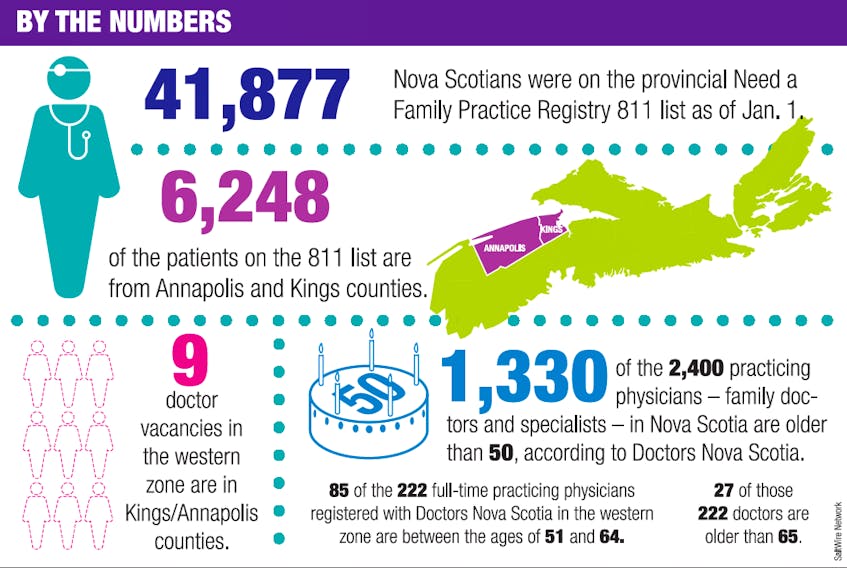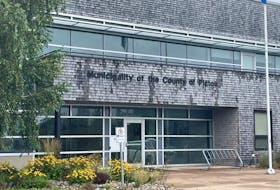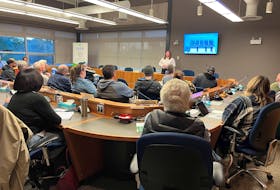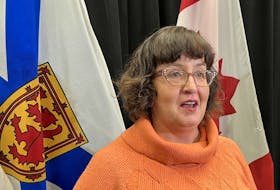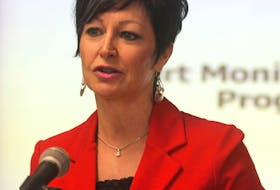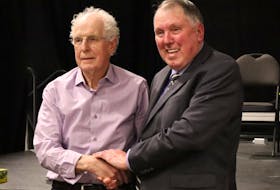ANNAPOLIS VALLEY, NS - A medical doctor heavily immersed in local physician recruitment efforts says the demand for care cannot be met by doctors alone.
“We need more than family physicians - and I say that simply because I don’t think it would be possible to recruit enough family physicians to cover the need that is there and will continue to be there,” said Dr. Crystal Todd, Chief of Family Medicine for the Nova Scotia Health Authority’s western zone.
As of Feb. 4, Todd said nine of the 28 doctor vacancies in the zone were in Kings or Annapolis counties.
“There are seven community family physicians that have left their practices through retirement, illness or relocation and have yet to be replaced. We are also recruiting for two full-time hospitalists for Valley Regional Hospital to bring the numbers to full complement,” she said.
Todd sees the impact of the doctor shortage from the lens of a recruiter and a local family physician.
“I can say as a family doctor in the area, yes, there is an increase in requests coming through my office. I’m now getting requests almost on a daily basis from neighbours and family members and friends of people that are losing, or have lost, their family doctor,” said Todd.
6,248 waiting for doctors
A Need a Family Practice Registry report prepared by the Nova Scotia Health Authority for Jan. 1 shows 11,680 of the 41,877 Nova Scotians awaiting placement are based in the western zone, which spans from Kings County to Yarmouth and includes the South Shore. Of that, 6,248 are in Annapolis and Kings counties.
“For whatever reason… we have some areas where we have had groups of physicians that have left in close proximity of each other and that makes it feel like something enormous is suddenly happening,” said Todd.
Several vacancies have been filled in recent years, but Todd said it is not always possible for an incoming physician to take on all of the patients attached to a retiring doctor with a large practice.
“We encourage practicing physicians to talk to us as soon as they are thinking about retirement and we ask them frequently about retirement plans. The sooner we know, the sooner we can start looking for a replacement,” said Todd, noting that it is ideal when the new doctor can come in while the retiring physician is still working to allow for a gradual transition.
“Kings and Annapolis have traditionally been places that have been quite easy to recruit to and retain physicians. It’s a beautiful place and we have some great providers and facilities already established here.”
Read more about the family doctor crisis in Kings, Annapolis counties:
• ‘We shouldn’t have to wonder’: Doctor shortage hits home for Annapolis Valley
• More than 6,000 people in Kings and Annapolis counties don’t have family doctors. Meet some of them
• Wolfville doctor on the front lines of physician shortage worried about broken system
• Pharmacists ‘willing and able to help’ with doctor shortage stress
Collaborative care needed: Todd
Collaborative clinics like the new one in Kingston, family medicine residency programs within the Annapolis Valley, cooperation between the various healthcare providers and inviting communities are all key to physician recruitment and retention, said Todd.
“We’ve had great success with retention of our Annapolis Valley (medical) residents, success that ranks at about 90 per cent of the residents that have gone through the program.”
With many new doctors seeking collaborative working environments, Todd sees family physicians, nurse practitioners, family practice nurses, pharmacists, social workers, dietitians and other healthcare professionals teaming up more and more to meet the needs of patients.
Kevin Chapman, director of finance and partnerships for Doctors Nova Scotia, is encouraged by the steps taken to promote the use of collaborative care models and implement residency programs in rural communities.
“We’re concerned when we see over half of the physicians in the western zone are over 50 years old,” he said, noting that more physicians in the city can solely focus on office work while doctors in rural areas often take on added responsibilities like surgical assists, emergency department shifts, hospital work and nursing home visits.
“Providing care in a small town like Annapolis or Middleton is very different. You do a lot of things that you don’t do in the city.”
Healthcare providers and community members alike all have a role to play in ensuring medical residents and new physicians are welcomed by a network of support upon their arrival, said Chapman.
“Give them a good experience while they’re here.”
Doctors Nova Scotia spokesperson Barbara Johnson stressed that retention is crucial at a time when more than half of the practicing family physicians and specialists in Nova Scotia are older than 50.
“This is important because our province will be in a recruitment mode for years to come.”

